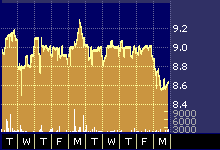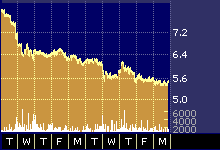
Stalled Fuel Cell IPOs Leave Upside
Stalled Fuel Cell IPOs Leave Upside
By Hal Plotkin
Silicon Valley Correspondent
Two fuel-cell companies that went public last week in lackluster initial public offerings may still offer investors upside potential, analysts say.
Last week’s disappointing IPO from fuel-cell pioneer H Power Corp. {HPOW} leaves the stock well positioned to move up, as demand surges for new sources of reliable electricity, observers say.
“H Power is selling systems and taking orders,” says Michael Kujawa, director of energy research at Allied Business Intelligence in Oyster Bay, N.Y. “I’m really surprised H Power didn’t do better. They have a deal with a major [energy] co-op serving one-third of the consumers in the U.S.”
Clifton, NJ-based H Power shares began trading last Tuesday at 16, which was 3 above the high end of the firm’s initial filing range.
Meanwhile, shares of Eatontown, N.J.-based Millennium Cell Inc. {MCEL} started trading on the same day at 10 each, which was at the low end of the range initially targeted by the company.
Both stocks sagged immediately after hitting the market.

Millennium Cell Post-IPO Performance

H Power Post-IPO Performance
Despite their performance, analysts who follow developments in the fuel-cell industry say both companies have a shot at becoming major players in a sector that is expected to become ubiquitous over the next decade.
An investment in Millennium Cell, though speculative, could pay off big, they say, if the company succeeds in its goal of making it possible to use less expensive fuels in fuel cells.
At the moment, though, analysts give the nod to H Power, which already has a technology needed by increasingly voracious electricity customers.
“In 10 years, fuel cells are going to be everywhere you use power,” Kujawa says. “They’re going to be in your car, in your cell phones, in your computers, in your house, in your walkman, absolutely everywhere you plug something in. It’s a huge, important trend.”
In addition to H Power and Millennium Cell, many rivals, such as Ballard Power Systems Inc. {BLDP}, FuelCell Energy Inc. {FCEL}, and Plug Power Inc. {PLUG}, are all targeting the nascent fuel-cell market.
Analysts say Ballard Power Systems is particularly well entrenched in emerging fuel-cell automotive markets, as well as stand-alone power systems. FuelCell Energy is one of the older, more-established players, while General Electric Corp.’s {GE} fuel-cell division, MicroGen Inc. will begin selling fuel cells manufactured by Plug Power next year. [General Electric is the parent of CNBC.com].
Fuel-cell technology is currently most cost-effective for consumers who need more-reliable electricity supplies, such as high-tech factories or banks, or for customers who are located off the power grid at distances where stringing new wires becomes impractical.
Fuel-cell makers say users of their products are largely immune to the power shortages, blackouts and occasional interruptions in service that can be catastrophic in many settings. Although the costs of fuel-cell electricity remains higher than conventional power, in many cases the increased reliability more than makes up the difference.
According to one estimate, for example, an eight-minute power outage at a large bank, which is the national average downtime per year, costs the bank more than the difference between cheap grid power and more reliable fuel-cell power. Similarly, the costs associated with power interruptions at high-tech manufacturing plants can be enormous if production lines are shut down and must be reset before they can be restarted.
Eventually, however, fuel-cell companies could grab a major slice of the overall power-generation market.
Steadily rising costs for natural gas, which is used to fuel most modern conventional electric-power generators, for example, are beginning to make fuel cell-generated power more competitive, price-wise, for end-users.
In addition, analysts say that the entire fuel-cell industry, which also has significant automotive applications, is poised to explode if the price of gasoline stays high and if demand for electricity continues to outpace supply.
“The trends are for fuel-cell power to be directly competitive with grid power in two to three years,” Kujawa says. “The infrastructure to support fuel-cell cars isn’t there yet, but it’s on the way.”
Fuel cells use a chemical rather than mechanical process to create electricity. The technology taps the energy stored in hydrogen, which can be extracted from a number of different fuels, including gasoline and methanol. Stand-alone fuel-cell units are already powering some small communities, universities, rural utilities and industrial parks. As demand increases, the units feed themselves more fuel and pump out more electricity.
The technology is also seen as a key to the next generation of energy-efficient, low-polluting automobiles. Most of the major auto makers have fuel-cell cars either in the design stages or in early test-marketing programs.
At the same time, analysts say the technology is also working its way into battery applications for mobile devices. In a few years, maybe sooner, a
cell-phone owner should be able to buy a lightweight fuel-cell battery that lasts a month or more before being recharged in seconds by replacing a small, self-contained inexpensive vial of methanol or some other fuel.
“We have the general impression that fuel cells are going to be cost competitive and environmentally competitive,” says Maurice Schoenwald, founder and co-manager of the $45 million New York-based New Alternatives fund, which focuses on socially responsible investment opportunities.
Schoenwald started his fund with backing from several friends and associates in 1982, who together came up with the $100,000 required to qualify as a regulated mutual fund.
Fuel-cell technology was an early focus. The fund bought FuelCell Energy stock, for example, when it was trading below 10. The stock closed at 80 on Tuesday.
“It’s done magnificently for us,” Schoenwald says.
Schoenwald says he bought into H Power’s stock at what turned out to be a premium price, prior to last week’s offering.
“We can’t decide which fuel-cell companies are going to do the best,” Schoenwald says. “So we like to take a position in as many of the entities that look as solid as possible.”
Schoenwald adds that H Power’s traction in the market, particularly in rural markets, gives him confidence in the firm’s prospects.
He didn’t bite, however, at the Millennium Cell IPO. That firm is working to perfect technology that would allow fuel cells to run on sodium borohydride, which is similar to a common and inexpensive household cleanser.
“Millennium is developing a new way to deliver hydrogen,” says Sandy Thomas, vice president at Directed Technologies Inc. a high-tech consulting and research and development firm based in Arlington, Va., that was hired by an auto maker to evaluate the technology. “It’s very unique and has potential. But right now, they are the renegade in the fuel-cell market.”
Thomas adds that Millennium investors will have to be very patient, though, since the automotive market targeted by that firm won’t develop overnight.
“Before Millennium’s train can pull out of the station, a whole other train —
fuel-cell cars — has to get moving first,” Thomas says. “On the other hand, if their technology works as well as they say it does, they might be able to get that first train moving out of the station faster.”
While a believer in the technology, Thomas says investors shouldn’t get too caught up in the hype surrounding fuel cells.
He says that when all the costs are factored in, current fuel-cell technologies are still producing electricity at about four times the average per-kilowatt cost for most small users, as compared with conventional electricity rates.
But Thomas also notes that energy deregulation, which recently led to a near tripling of rates for electricity in San Diego, is beginning to tip that balance. San Diego was the first region in California to feel the effects of utility deregulation, which is scheduled to take effect across the entire state over the next few years.
“We’re very skeptical right now on the idea of fuel cells for the home or small business,” Thomas says. “It not cost-effective. But once you start going up in size it becomes a different picture.”
In addition, the technology’s benefits are much more apparent right now in the rural markets targeted by H Power and other mainstream competitors, such as Ballard Power Systems and Plug Power, Thomas says. In those settings, it often costs between $10,000 and $30,000 a mile to string new power lines. By contrast, a fuel cell can be located on the premises where the power is needed.
Thomas also agrees that increased demands on the power grid, which are leading to shortages and roving brownouts in some areas, leave many businesses looking for more reliable supplies.
“Those are the best markets for today,” Thomas adds. “Where it goes from there depends a lot on investment levels. If the auto companies and energy companies don’t jump start it, it would develop a lot slower.”
Schoenwald says slow and steady is fine with him.
“I think fuel cells are going to be able to produce electricity at prices at or better than the competitive technologies,” he says. “We’re not looking to be heroes flying in the air. We like slow and steady growth.”
H Power, which was founded in 1989, posted a loss of $6.1 million on revenue of $2.6 million for the nine months ended Feb. 29.
Millennium Cell, which was founded in 1999, posted a loss of $431,000 on zero revenue for the three months ended March 31.


